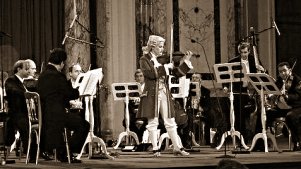Introduction
Next up in my listening of the Complete Bach Edition set of CDs is The Goldberg Variations. At the same time I listened to this CD, I also listened to a new interpretation by Simone Dinnerstein, played on a 1903 Hamburg Steinway concert grand instead of the harpsichord version (played by Pieter-Jan Belder) from the Bach Edition CD. Listening to the two versions side by side was really helpful in identifying the differences between the variations, and the juxtaposition of harpsichord and piano makes the whole exercise very enjoyable.
Bach’s first biographer, Johann Nicolaus Forkel (1802) claimed that the Goldberg Variations were commissioned by Count Hermann Carl von Keyserlingk, who had trouble sleeping. He told Bach “that he should like to have some clavier pieces for his house harpsichordist, Johann Gottlieb Goldberg, which should be of such a soft an somewhat lively character that he might be a little cheered up by them in his sleepless nights.” (quoting from Christoph Wolff’s biography of Bach). Unfortunately, at the time they were published in 1741 as the fourth part of Bach’s Clavier-Übung (keyboard practice), Goldberg was only 14 and probably couldn’t have played these difficult pieces. Also, the Variations weren’t dedicated to von Keyserlingk, as would have been required at the time if they’d actually been commissioned by him.
The Goldberg Variations begin and end with an aria, and in between there are 30 variations on the original. Every third variation is a canon (a work with a leading melody and an imitative follower that's offset in timing), and the tenth is a fugue (a sort of complex canon). According to the liner notes, the “bass and harmonic structure” are preserved in all the variations. I have a rudimentary sense of what that means, but when I listen to the pieces, I don’t really hear the similarities at all. I’d probably recognize them as being different from a solo keyboard work by Chopin, but that’s not the same thing as really understanding what’s going on. Luckily, musicologically (?) understanding it isn’t a requirement of enjoying it.
I found Donald Satz’s 2000 discussion on the Bach Cantatas website of a series of Goldberg recordings to be very helpful in listening to the two versions I’m considering here, even though he doesn’t consider these recordings specifically. I include a few of his observations in the variation descriptions below.

goldberg variations, simone dinnerstein
The Variations
As mentioned, I listened to a version on harpsichord and a version on piano. I’d never really payed much attention to the sound of a harpsichord, but unlike a piano, the strings on a harpsichord are plucked by the mechanism, rather than being struck by a hammer. It results in a sharper sound, and to me, it’s easier to distinguish both individual notes and the different hands playing at the same time. I find it harder to distinguish the two hands with piano, but the sound is much smoother and expressive. The ability to carry emotion comes through in the piano version of the aria, played very slowly, luxuriously by Dinnerstein. The timing on the two versions aren’t all that different (5:03 for Belder, 5:39 for Dinnerstein), but Dinnerstein’s version really feels relaxed.
The first variation charges out of the gate after the aria with lots of counterpoint and a nice fast rhythm. Hearing it on harpsichord, I immediately hear “baroque.” The harpsichord version also really emphasizes the different hands playing two contrasting melodies. Dinnerstein seems to be playing it even faster, and maintains the upbeat cheerful sound. The subtlety possible with the piano is also clear here, where she starts some of the melodic repeats quietly the first time through, and emphasises them the second time.
The second variation also has a lot of contrasting melodies, but this time the two hands go farther away from each other, so the piece sounds more complex. It’s also quite short, over before you know it. Dinnerstein slows down quite a bit, and it sounds quite different as a result. Less about counterpoint and technical prowess, and more about atmosphere.
Variation three sounds more full; both hands working very hard on their respective melodies. It really sounds quite challenging on harpsichord. On the piano, it’s still a complex piece, but I don’t get the sense that all the notes are coming together as chords. Again, this may be because Dinnerstein’s pacing is much slower (3:25 to Belder’s 2:01).
The fourth variation is very rhythmic in both versions and the solid beat of the piece really carries you along. Thus far, this piece seems most similar between the two interpretations.
The next variation is very fast and melodic with some great opportunities to allow subtle changes in timing to really enhance the music. I really like the way the measures (if that’s even the right word) end with a short melody, chord, and then a very short pause before continuing. Dinnerstein really flies through this one.
Variation six has a different sound than what we’ve heard so far, and I think it’s because the melodies and bass line are lower than before. It’s not my favorite variation.
Seven is happy, frivolous sounding music, maybe something you’d hear playing at a seventeenth century society ball, or a piece you’d play to entertain a baby. Dinnerstein plays it very slowly, making the little trills sound even more frivolous when she gets to them.
The eighth variation is another rhythmic piece that reminds me of the fourth variation. But the longer, complex melodies in it make it sound like something other than a baroque piece, especially on piano.
Variation nine is an emotional piece without a lot of melodic or counterpointal flourish. Belder plays it slow and sweet, giving it room to work. Dinnerstein plays it more quickly, but she varies the timing and loudness of the notes nicely, which really brings out the touching parts of the music.
The tenth variation is a fugue with lots of voices and counterpoint, but despite all the things going on simultaneously, it lacks the little melodic touches and hooks that the other variations have. Dinnerstein and Belder’s versions are very similar; both seem to be just playing it straight up without any interpretation.
The eleventh returns to form, and Bach seems to be emphasizing downward scales in this one. It seems like one hand is always working it’s way down a scale in this one. I don’t get much emotion out of it, beyond a sense of playfulness, even if it doesn’t reach the level of variation seven. I like Belder’s version here, mostly because I get a little distracted by the little trills when they’re played on the piano.
Variation twelve doesn’t do much for me, especially in Belder’s hands. I like the brief melody that starts the piece and occurs a couple other times after lulls in the cacophony, but after that, it all sounds like a jumble of notes and I can’t really pick much out of the noise. Dinnerstein is better just because it sounds smother, but I have the same problem of not being able to really pull anything out of the sound the grab onto.
The thirteenth starts off confused, just like the twelfth variation, and I admit that I really couldn’t make much out of this one. There are a few moments where a couple riffs on scales brought my interest back, but then lost it again.
The fourteenth variation comes back to more of what I like in the other variations, melodies contrasting and combining together, with a lot of interesting changes throughout. It sounds like it’s a difficult one to play also, Belder makes a strange knocking noise about a quarter of the way in, as though he accidentally banged into some part of the harpsichord trying to play the piece. Some of the magic is lost in Dinnerstein’s performance because it sounds to me like she’s playing it so quickly that she doesn’t quite get all the notes to play fully. Maybe this is one advantage of the harpsichord’s plucking mechanism; each note will be heard, even if some of the variety is missing.
Variation fifteen is a dark, sad sounding piece in a minor key (according to Satz, only 15, 21 and 25 are). It seems very slow after hearing number fourteen, but despite the pace and somber emotion, it’s very interesting. The two hands seem to play off each other more in timing than in tone, with one hand striking a note, pausing noticeably before the other hand answers with a single or series of notes. The last note, struck so late after the previous note is really poignant. Dinnerstein also uses the timing of the piece really effectively to enhance the emotion of the piece. Great stuff, even if (maybe because) it’s completely opposite from the bright, happy works that make up most of the Variations.
Number sixteen sounds almost dance-like in that the piece seems to be playing up on it’s toes for the majority of the piece. Belder’s version is more than a minute longer than Dinnerstein but doesn’t sound slower, so I’m not sure where all the time goes.
To me, variation seventeen sounds similar to eleven in that there’s a distinct emphasis on scales. This time around there’s more variation around the scales themselves, and they seem to go both up and down. Dinnerstein plays this piece really fast compared to Belder, and it sounds better this way than her interpretation of the eleventh. Both of these variations are really good, and what’s cool about these two is that they really show how interpretation is critical. They each do something completely different with the same piece, and get really good results for different reasons.
Eighteen is a nice poetic and melodic piece that doesn’t depend on speed or overt complexity to keep the listener interested. Both interpretations are similar in speed and style, and both sound great.
Satz describes variation nineteen as “feel-good” music, and I agree. It’s another one that has a nice sense of rhythm that carries you along with the melodies being played. Belder must be skipping a bunch of repeats in his version because it’s over in only 39 seconds. Just as I was getting into it, the thing was over. Dinnerstein takes almost two minutes for her version, which is much better. She’s varying the rhythm a bit more, and also effectively changes the feel throughout by managing how hard she’s striking the keys.
Both Belder and Dinnerstein play variation twenty like it was a challenge to see how quickly they could fly over the keys, and Dinnerstein loses a lot of emotion by playing it this way. Both versions are invigorating and impressive, but I think they could have been more expressive.
Variation twenty-one is another minor key variation, and it’s really poetic. Belder uses timing really well and effectively carries the emotion throughout. Dinnerstein plays it nice and slow, really picking up all the emotion. The way she slows and quiets down her playing on the first repeat at 1:10 is fantastic and contrasts nicely with the more forceful playing elsewhere in the variation. Her version is two minutes longer than Belder’s, giving her more range to explore.
Twenty-two is a vibrant, upbeat piece for Belder; Dinnerstein plays it much more reflectively. I’m not sure which interpretation I like better, but this is another example of the great variety of interpretation possible in Bach’s music. Both versions make me smile: Belder uses dance-like rhythm and upbeat playing, while Dinnerstein lets the infectious melodic hooks carry me through her version.
The next variation continues the upbeat theme, but is a lot more complex. Satz uses the word “rollercoaster,” which does fit the piece. I found Belder to be a bit disjointed and it didn’t seem to hang together as a unified work. Dinnerstein makes it sound more fluid, but I think there’s just too much going on here for me to be really satisfied.
Variation twenty-four is a reflective work that’s neither upbeat nor sad, but has a nice relaxing pace and reduced complexity after 22 and 23. I got a little lost by the end of both versions, the variation turning into sound rather than music, and I think this probably means I’m getting tired. For me, listening to music of this complexity, especially twice for each variation, is a challenge to my ears and mind.
Variation twenty-five has been called the “Black Pearl” because of how dark and depressing it is supposed to be. It’s the final variation in a minor key, and I agree with Satz that it’s the least effective of these three. Fifteen and twenty one were both emotional and dark. This one just seems to plod along in Belder’s version, never really getting anywhere or eliciting any feeling at all. Dinnerstein does a lot better for me, with nice pacing and expressive playing. Even so, I think it’s the least interesting of the three minor key pieces.
The twenty-sixth variation is a very fluid, engaging work with one hand playing a reasonably simple melody while the other hand ranges all over the keyboard. Dinnersteing plays it incredibly fast but not firmly enough to really carry the entire melody. I appreciate the challenge, but it’s not a great interpretation of the music. She does build to more of a climax than Belder does, but I still liked his version better.
Variation twenty-seven is more playful, melodic music. Belder goes from start to finish in just over a minute, making the work too short to appreciate. Dinnerstein takes twice as long, and I really like her version.
Variation twenty-eight starts with one hand playing a light melody while the other plays non-stop trills. There are a few breaks where something else is going on, but the majority of the piece continues this way with one hand crazily dinging up and down while the other plays something simple. It’s not my favorite combination, and gets really repetitive by the end. Belder goes on for two minutes and 44 seconds before yielding. Dinnerstein’s version is a minute shorter, and she plays all the trills with a really light hand, bringing as much beauty out of the piece as might be possible. When her’s first started, I couldn’t believe how much more relaxing all the hammering sounded compared with Belder’s harpsichord. It’s still not my favorite, but it’s much easier to listen to.
Twenty-nine is a toccata that covers a lot of ground. The variation means that it was difficult for me to concentrate on it because I never knew where it was going to go next, and there didn’t seem to be a unifying melody or rhythm that drew me from one part to the next.
The final variation starts with a nice simple melody and accompaniment. These simple themes continue throughout, with a nice rhythm to keep it moving. It’s a graceful and relaxed way to end the variations. Both versions are similar in pacing and in the limited amount of flourish added around the edges of the work.
After the thirty variations, the initial aria is repeated. One of the eMusic reviews I read of the Goldberg Variations said that you wouldn’t hear the initial aria the same way at the end, after hearing all the variations. I’m afraid that even with careful listening, I wasn’t able to pick up on exactly how the Variations were actually related to the initial and concluding aria. As far as I can tell, I’m just hearing the aria again.
Summary
It was really informative to listen to two versions side by side. Both versions were really well played, and I didn’t hear any huge mistakes either in technique or interpretation (although I’m far from an expert). I enjoyed the clarity of the harpsichord, and the light-hearted feeling it was able to give to the music, but often it made the Variations sound more technical and difficult, almost like an exercise. Also, Dinnerstein brought out more emotion and less of a feeling of it being a challenge to meet, and her slow pacing in a lot of the variations was a welcome change from Belder’s furious noise. But both versions had their good and bad parts, and I’d certainly recommend listening to more than one, especially if you can hear both harpsichord and piano.

american pie cover
It’s become a Sunday night tradition to bake a pizza using Peter Reinhart’s whole grain pizza dough recipe from his whole grain bread book. Yesterday I bought his 2003 book on pizza. I don’t know that I’ll be giving up the whole grain dough for a more traditional white flour crust, but this evening’s pizza will feature one of the sauces from the book. We had been using a Cook’s Illustrated recipe, but Reinhart says that the two tricks to a great pizza sauce are a bit of acidity (vinegar or lemon juice), and not overcooking the tomatoes. Since we’re using canned crushed tomatoes, which are already cooked during canning, he claims cooking them a second time is unnecessary and will dull the flavor and brightness of the sauce. We’ll find out.
The book starts with his hunt for the best pizza in the world, which takes him to Italy, New Haven, Philadelphia, Providence, New York, Arizona (where the best pizza was, believe it or not), and several other cities. His conclusions at the end are that the are great pizza places that are great because of their context (the neighborhood, local traditions, your memories of the restaurant, etc.) and those that are great because they have a dedicated pizzaiolo that makes every pizza in the place. That sort of pizza parlor is rare, and so most good pizza is contextually good but not great. Regardless, next time I visit any of the cities in the book, I’ll have to check out some of the places he reviews.
The rest of the book discusses what it takes to make good pizza at home, including setting up your oven, and making the dough, sauce, and toppings. He also has a detailed section about grilling pizza using techniques he learned from George Germon in Providence, who invented the style. There are a wide range of interesting recipes after this section. My only complaint with the second part is that the dough recipe ingredients are given only in volumes, not weights. He probably did this to make the recipes seem easier for a more general audience, but weights would have been helpful for those of us who regularly bake bread.
But that’s my only complaint. The first section is entertaining and is a great introduction to the variety of styles of pizza being made around the world, the instructions are solid and easy to follow and there are a lot of recipes to choose from. Finally, the publisher (Ten Speed Press) spent the money for a sewn binding, which means the book should last a lifetime and will lie flat without breaking.
photo by xrrr
Note: I started this post way back in July, and after moving into our new house I let it get away from me. I do still hope to continue listening to the whole of the Bach Edition, but as this long delay shows, it’s probably going to take a lot longer than I thought if I’m going to say much of anything about each disc. Yesterday I got Christoph Wolff’s one volume biography of Bach, Johann Sebastian Bach: The Learned Musician, and even though it’s not an analysis of his music (anyone have any suggestions for such a book?), it’s insights into the man may help me in understanding the music. I also got The NPR Guide to Building a Classical CD Collection, and the Violin Concertos are one of the discs that make up the “350 essential works.” The NPR book looks to be pretty good at answering the question of which pieces a classical newbie should listen to, but the CD recommendations themselves aren’t going to be very useful for me. eMusic has a fantastic classical selection, but the major record labels aren’t on there, so I’ll need to find the best from BIS, Naxos and other great independent classical labels.
The fifth CD in the Bach Edition set is a collection of Bach’s violin concertos: BWV 1041, 1042, 1052, 1056 and 1064. The BWV numbers are a way of thematically categorizing (instead of chronologically, like Opus numbers) Bach’s works, so it’s something of a surprise that the numbers aren’t consecutive on this disc. According to this Wikipedia page, BWV 1041, 1042 and 1056 are violin concertos, but BWV 1052, 1057 and 1064 are all categorized with the harpsichord concertos. As noted below, this is because evidence suggests that the harpsichord concertos were written from violin concertos which have been lost (and reconstructed here). This CD doesn’t include BWV 1043–1045, which are classified on the Wikipedia page with the rest of the violin concertos. I’m sure I’ll run into them as I work my way through the corpus but the disconnect is surprising.
Most of the pieces were recorded in 1992 by Camerata Antonio Luco, with Emmy Verhey on violin. The last piece, Concerto for 3 violins, strings, and basso continuo in D Major (BWV 1064) was recorded by the Amsterdam Bach Soloists in 1988.
Concerto for violin, strings and basso continuo in A Minor, BWV 1041
The liner notes for this CD say that this concerto follows a three movement “Vivaldi form” of fast-slow-fast, but that Bach improved on Vivaldi by better integrating the three parts into a unified form. I don’t think I’m a refined enough listener to see what they’re talking about, but I like the comparison to Vivaldi because it’s got the sort of fast pacing and interplay between the instruments that makes Vivaldi enjoyable. The piece starts out with a very lively tempo with different instruments playing against each other. The second part is slower and less remarkable (the liner notes call it a “cantilena”), but the final part returns to the faster rhythm with the soloists alternating with the full ensemble.
Concerto for violin, strings and basso continuo in E Major, BWV 1042
This is a very familiar concerto. The first movement starts with a “tutti theme” repeated throughout the piece, which means that all the instruments play together, rather than individual parts carrying the melody as is common in other sections. The slower second movement is carried by the solo violin, accompanied by a few instruments, harpsichord especially. Both the NPR guide and the liner notes mention how lyrical the solo line is in the second movement. The final movement is in “rondo form”, which the Wikipedia tells me means the principle theme is repeated with contrasting themes interspersed between. For me, I think it’s this form more than anything else that says Baroque to me when I’m listening to Bach. Here, the offsetting main and secondary themes switch back and forth rapidly (four or five times in the three minutes of the movement), keeping the listener interested in the piece without being distracted.
Concerto for violin and strings in D Minor, BWV 1052 (reconstructed from a harpsichord version that Bach arranged from this, missing, original)
Lots of Bach’s music has been lost, and the three remaining pieces on the disc are reconstructed from works for other instruments. The first one, Concerto for violin and strings in D Minor (BWV 1052) is reconstructed from a harpsichord version that exists but which Bach arranged from the original violin version which is no longer around. I suppose that with so much music available, an expert can see how Bach re-wrote is other pieces, and apply the same techniques to reconstruct music that is known to have existed.
I like the first movement of this one a lot. It seems to range wildly around, but always returning to the same melody with different instruments taking it up. And all throughout the movement, there are striking moments where a larger group of musicians plays the same theme. The movement also has an unusual sounding section in the middle where a pair of violins are playing melodies that sound dangerously close to being out of tune. The main melody intrudes a few times, and the movement eventually returns back to normal by the end. I’m sure there are terms for these things, and I’m going to have to figure out what they are so I don’t keep repeating the same awkward phrases over and over again.
The Adagio is much slower (which, it turns out, is what adagio means…) and on initial listens, it seems like there’s a lot less going on. But the slower sections allow the solo violin running through the movement to really carry a lot of emotion. The final movement returns to the faster tempo and interesting interplay between instruments.
Concerto in G Minor (reconstructed from the concerto for harpsichord and strings in F Minor, BWV 1056)
This short concerto is reconstructed from a harpsichord and strings concerto. The second movement also exists as the Sinfonia of Cantata number 156. The second movement also features the string players plucking their instruments behind the solo violin, which lends a very different sound to the piece, and keeps the focus more on the solo violin than if the strings were playing a melody with the bow.
Concerto for three violins in D major (arrangement of the concerto for three harpsichords and strings in C Major, BWV 1064)
The final work is another reconstruction based on evidence that Bach wrote his Concerto for three harpsichords using a version for three violins and strings that no longer exists. It’s a really bright concerto with a quick melody that sounds more like Mozart than Bach to me. Very enjoyable.
Next up would normally be two CDs of Harpsichord Concertos, including a different version of BWV 1056 I heard in the violin concertos. But I think I may jump into the Cantatas for a change of pace from all this orchestral music. I was originally going to listen to the whole thing in order, but I it may be more rewarding to jump around.
I’ve had Daniel Leader’s Local Breads: Sourdough and whole-grain recipes from Europe’s best artisan bakers long enough to read most of the text in the book and bake three of the more than fifty bread recipes inside. The book begins with a few introductory chapters discussing the methods, ingredients and equipment you’ll need to bake the breads in the book. Subsequent chapters begin with a long section describing Leader’s experiences in a particular region of Europe, discussing the bakers, ingredients and bakeries he came across in his travels. After that, there are several recipes based on what he learned. The recipes are all scaled down for home ovens and equipment, have ingredients measured in volumetric units, U.S. and metric weights, as well as baker’s percentages. He says that he tested all the recipes using a small KitchenAid mixer, and the mixing instructions include specific details on speed and time for that mixer (as well as hand kneading instructions for most doughs). The majority of the recipes use sourdough for the fermentation, but including whole-grain in the title is a bit of a stretch since very few recipes are more than ten or twenty percent whole-grain (not a complaint, just a warning). At the end of the regional chapters is a list of frequently asked questions and answers that are tailored to the recipes. This is a nice Book 2.0 addition that would be welcome in most sophisticated baking books.
The three breads I’ve baked so far are his Old World Baguette (Paris), Buckwheat Batard (also Paris), and Whole Wheat Genzano Country Bread (Genzano, Italy). All of them were excellent, and the techniques involved were different from the recipes I’ve tried from Hamelman, Reinhart, or Beranbaum mostly because the doughs were so wet that they were difficult to shape using the techniques I’ve used in the past. If you’re going to be baking the breads from this book, you’ll probably need a good peel or a lot of parchment paper and a stand mixer.
Because the recipes are taken from different regions with their own baking traditions, there is less unity in technique than in the other books mentioned. Hamelman focuses on developing gluten with as little mixing and kneading as possible to maximize flavor and longevity, and the Reinhart whole grain book I recently reviewed revolves around pre-ferments and soakers or mashes. In Leader’s book you’ll find recipes using liquid levian, dough-like starters and starters raised on different grains; long-fermenting recipes with retarted proofing and recipes that are ready to bake a few hours after you start; recipes with a lot of kneading and recipes with much less. It’s a nice variety, and I’ve enjoyed seeing the results of variations in ingredients and technique in the final bread.
My only complaint with the book is that it’s not a sewn binding, which means that the book will eventually fall apart with the hard use it experiences in the kitchen. Hamelman’s bread book suffers from the same poor quality binding, and my copy recently split after three years of use. Contrast that with Whole Grain Breads, which has a sewn binding: it lays flat on the counter and will last a lifetime. Considering that both books list for $35, it’s a shame that Norton couldn’t produce a book up to the standards set by Ten Speed Press.
One other note: I’ve used my new SuperPeel (it’s the peel in the top photo) four or five times and I’m very happy with it. Thus far I haven’t used it to pick anything up, but it’s very good at smoothly laying dough down onto my baking stone in the oven, and when the belt is properly floured, the dough doesn’t stick to it. The only issue so far is that I haven’t found the optimum belt length yet such that the belt is tight to the peel but still allows it to move easily. My previous method for handling dough was to proof the loaves on a Silpat, which is a sort of reusable silicone parchment paper. It is very durable and works, but because the bread isn’t being place directly onto the heated stone, I wasn’t getting as much oven spring as I do now with the SuperPeel. Later this week I’m planning to make pizza, and we’ll see how easy it is to pick up and put down a big pizza. That’s the true test.
A couple weeks ago I finished reading Peter Reinhart’s Whole Grain Breads, and baked my first loaf. I chose the whole wheat sandwich loaf even though I much prefer hearth breads because it was the teaching recipe that all the other recipes are based on. The bread was fantastic; sweet, not too dry, and with a lot of wheat flavor. And, best of all for a homemade sandwich bread, it lasted until Friday without losing any of it’s flavor or character.
I have also made the whole wheat pizza dough twice, and it’s equally good. Our previous dough recipe was Cook Illustrated’s 75-minute pizza dough, which tastes pretty good, and has sufficient gluten development to form a pizza crust, but once it’s baked with sauce, toppings and cheese, it’s not really strong enough to handle picking up the slices. The whole wheat dough was sturdy enough, and again, it had the same sweet wheat flavor and nice texture as the sandwich loaf. The recipe in the book makes five individual pizzas, which was more dough that I needed for a single large pizza (I reduced the recipe by 25% the second time around and it was perfect) so I used the leftover dough the next day to bake a small loaf in the wood stove oven. The oven was around 425°F, which is a little hotter than the baking temperatures in the book, and I should have rotated the loaf half-way through because the oven heat isn’t very even, but the loaf came out great.
Since then I’ve made whole wheat hearth bread, which was tasty, but lost some of it’s height when I transferred it to the baking stone (I’ve got a Super Peel coming, which should help with this problem), and oat bran broom bread. Both came out great tasting with excellent crumb, and still had great texture and flavors when I finished the loaf.
The method used in almost all the breads in the book is different than any of the techniques I’ve seen in other books. Most quality breads have a long pre-ferment, either using sourdough or a lightly yeasted dough that rises slowly overnight and is mixed in on baking day, and usually feature low amounts of yeast which require long several-stage fermentation on baking day to develop gluten and the yeast. Reinhart’s method for developing the dough is to use a lightly yeasted pre-ferment as in the other recipes, plus an soaker that rests overnight at room temperature. These two doughs form the majority of the final dough. They’re mixed on baking day with the rest of the ingredients, and a relatively large amount of yeast. Since the flavors and structure has already been developed in the two overnight doughs, there’s no reason for a long fermentation on baking day. The technique also works wonders on whole grain flours, which can result in dense loaves in traditional recipes.
The result is bread with all the flavor and keeping potential of traditional recipes but you can use much higher percentages (like 100%) of whole grain flours with greater confidence that the bread will turn out, and best of all, baking day becomes a two hour process, rather than a four to six hour, multiple stage, slow fermentation procedure. I’m not going to abandon my other bread books, but it’s great to have more techniques at my disposal when deciding what kind of bread to make. And Reinhart can be commended for all the research and testing he did to develop the methods in this book.
I highly recommend Whole Grain Breads to anyone who is really interested in bread baking, especially if you’re ready to jump onto the whole grain bandwagon.





